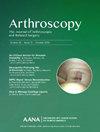Greater Postoperative Biceps Tendon Migration After Arthroscopic Suprapectoral or Open Subpectoral Biceps Tenodesis Correlates With Lower Patient-Reported Outcome Scores
IF 4.4
1区 医学
Q1 ORTHOPEDICS
Arthroscopy-The Journal of Arthroscopic and Related Surgery
Pub Date : 2025-05-01
DOI:10.1016/j.arthro.2024.07.037
引用次数: 0
Abstract
Purpose
To assess the relation between tendon migration, as measured by radiostereometric analysis, and patient-reported outcome measures (PROMs) after biceps tenodesis (BT); to determine the likelihood of achieving clinically significant outcomes (CSOs) after BT; and to identify factors that impact CSO achievement.
Methods
Patients undergoing arthroscopic suprapectoral or open subpectoral BT at a single, high-volume academic medical center were prospectively enrolled. A tantalum bead sutured to the tenodesis construct was used as a radiopaque marker. Biceps tendon migration was measured on calibrated radiographs at 12 weeks postoperatively. PROMs (Constant-Murley, Single Assessment Numeric Evaluation [SANE], and Patient-Reported Outcomes Measurement Information System–Upper Extremity [PROMIS-UE] scores) were collected preoperatively and at minimum 2-year follow-up.
Results
Of 115 patients enrolled, 94 (82%) were included (median age, 52 years; median body mass index, 31.4). At a mean follow-up of 2.9 years, the median Constant-Murley, SANE, and PROMIS-UE scores were 33 (interquartile range [IQR], 26-35), 90 (IQR, 80-99), and 47 (IQR, 42-58), respectively. Median tantalum bead migration was 6.5 mm (IQR, 1.8-13.8 mm). There were significant correlations between migration and Constant-Murley score (r2 = 0.222; β = –0.554 [95% confidence interval (CI), –1.027 to –0.081]; P = .022), SANE score (r2 = 0.238; β = –0.198 [95% CI, –0.337 to –0.058]; P = .006), and PROMIS-UE score (r2 = 0.233; β = –0.406 [95% CI, –0.707 to –0.104]; P = .009). On univariable analysis, higher body mass index was associated with achievement of substantial clinical benefit (unadjusted odds ratio [OR], 1.078 [95% CI, 1.007 to 1.161]; P = .038). Greater bead migration was negatively associated with achievement of the minimal clinically important difference (unadjusted OR, 0.969 [95% CI, 0.943 to 0.993]; P = .014) and patient acceptable symptomatic state (unadjusted OR, 0.965 [95% CI, 0.937 to 0.989]; P = .008) on all 3 instruments.
Conclusions
A 1-cm increase in post-tenodesis biceps tendon migration was associated with a decrease in the Constant-Murley, SANE, and PROMIS-UE scores of 6, 2, and 4 points, respectively, at a mean of 2.9 years after surgery. Most patients achieved CSOs for these PROMs by latest follow-up, and greater biceps tendon construct migration was negatively associated with the likelihood of CSO achievement.
Level of Evidence
Level IV, retrospective case series.
肱二头肌腱鞘切除术后肱二头肌肌腱移位较多与患者报告结果评分较低有关。
目的:评估肱二头肌腱鞘切除术(BT)后通过放射性立体计量分析(RSA)测量的肌腱移位与患者报告的结果指标(PROMs)之间的关系;确定BT术后实现具有临床意义的结果(CSOs)的可能性;并确定影响实现CSOs的因素:方法: 前瞻性地招募了在一家高容量学术医疗中心接受关节镜胸骨上或胸骨下开放式 BT 的患者。将一颗钽珠缝合到腱鞘构造上作为放射性不透明标记。肱二头肌肌腱移位在术后12周的校准X光片上进行测量。术前和随访≥2年时收集PROMs(Constant-Murley评分[Constant]、单一评估数值评价[SANE]和患者报告结果测量信息系统-上肢[PROMIS-UE]):在 115 名登记患者中,94 名(82%)患者被纳入(中位年龄=52 岁,体重指数=31.4 kg/m2)。在平均 2.9 年的随访中,Constant、SANE 和 PROMIS-UE 的中位数分别为 33(四分位距 [IQR]=26-35 )、90(IQR=80-99)和 47(IQR=42-58)。钽珠移位的中位数为 6.5 毫米(IQR=1.8-13.8)。迁移与Constant(r2 = 0.222,beta= -0.554,95% CI -1.027- [-0.081],P=0.022)、SANE(r2 = 0.238,beta= -0.198,95% CI -0.337 - [-0.058],P=0.006)和PROMIS-UE(r2 = 0.233,beta= -0.406,95% CI -0.707 - [-0.104],P=0.009)之间存在明显相关性。在单变量分析中,较高的体重指数与获得实质性临床获益(SCB,unadj-OR=1.078,95%CI 1.007-1.161,P=0.038)相关。在所有 3 种工具中,更大程度的微珠移位与最小临床意义差异(MCID,unadj-OR=0.969,95% CI 0.943-0.993,P=0.014)和患者可接受症状状态(PASS,unadj-OR 0.965,95% CI 0.937-0.989,P=0.008)的实现呈负相关:结论:术后平均 2.9 年,腱鞘肱二头肌肌腱移位每增加 1 厘米,Constant、SANE 和 PROMIS-UE 分别下降 6 分、2 分和 4 分。大多数患者在最近一次随访时在这些PROMs中取得了有临床意义的结果(CSOs),肱二头肌肌腱结构移位的程度与取得CSO的可能性呈负相关:证据级别:IV,回顾性病例系列。
本文章由计算机程序翻译,如有差异,请以英文原文为准。
求助全文
约1分钟内获得全文
求助全文
来源期刊
CiteScore
9.30
自引率
17.00%
发文量
555
审稿时长
58 days
期刊介绍:
Nowhere is minimally invasive surgery explained better than in Arthroscopy, the leading peer-reviewed journal in the field. Every issue enables you to put into perspective the usefulness of the various emerging arthroscopic techniques. The advantages and disadvantages of these methods -- along with their applications in various situations -- are discussed in relation to their efficiency, efficacy and cost benefit. As a special incentive, paid subscribers also receive access to the journal expanded website.

 求助内容:
求助内容: 应助结果提醒方式:
应助结果提醒方式:


